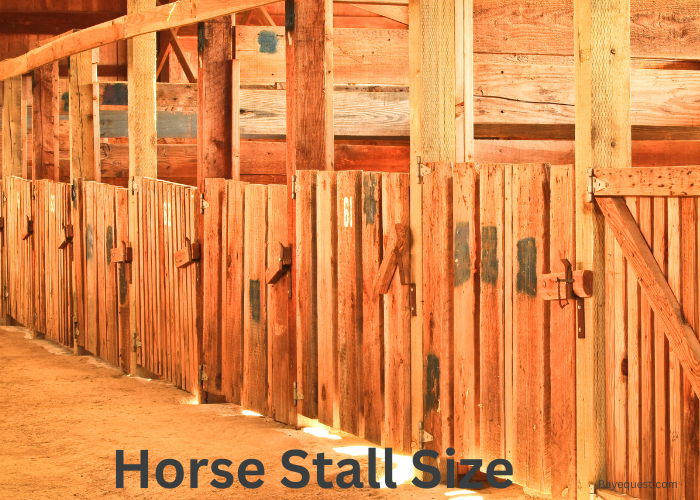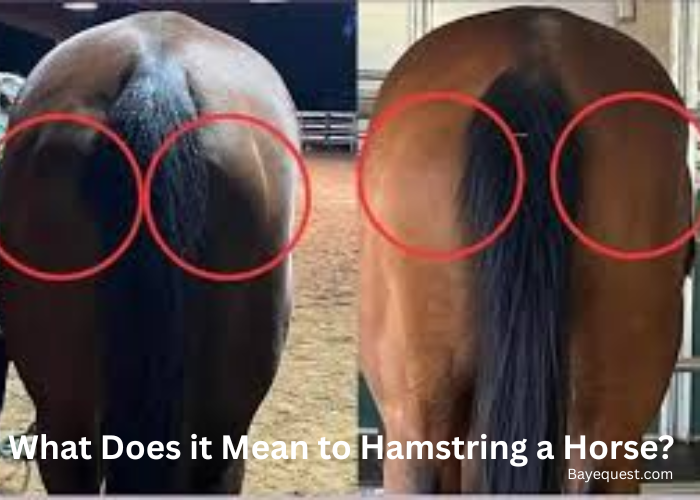A horse spends a lot of time in its stall. This space isn’t just a shelter; it’s a home.
The right stall size can make a big difference in your horse’s comfort and health.
Too small, and they feel cramped. Too large, and it might be harder to keep clean.
Finding the perfect size depends on your horse’s breed, size, and needs.
Whether you’re planning a new barn or upgrading an old one, understanding stall dimensions is key.
Let’s explore what works best for your horse.
Horse Stall Size: Key Takeaway
A standard horse stall is 12×12 feet, ideal for most adult horses. Ponies fit well in 10×10 stalls, while draft horses need 14×14. Stall ceilings should be at least 8 feet high for safety. Proper stall size ensures comfort, reduces stress, and promotes better health for your horse.
How Big Should a Horse Stall Be? Horse Stall Standard Size
A standard horse stall is typically 12 feet by 12 feet.
This size is ideal for most adult horses, providing enough room for them to move comfortably, lie down, and turn around without feeling cramped.
Smaller horses, like ponies, may do well in a 10-foot by 10-foot stall. Larger breeds, such as draft horses, might need stalls measuring 14 feet by 14 feet or more.
Stall height is another crucial factor. Ceilings should be at least 8 feet high, though 10 feet or higher is better for ventilation and safety.
Proper stall dimensions ensure your horse feels comfortable, safe, and relaxed.
Related read: How Big Should a Horse Arena Be?
Factors to Consider When Choosing a Horse Stall
Choosing the right horse stall involves more than just picking a size. Let’s break down the key considerations to help you make the best choice.
Horse size and breed
The size and breed of a horse are key factors in determining stall dimensions.
Larger breeds, such as draft horses, require more space due to their size, typically needing stalls at least 14 feet by 14 feet.
This allows them to move freely, lie down, and turn around without feeling restricted.
Smaller breeds, like ponies or miniature horses, can comfortably fit in 10 feet by 10 feet stalls, which still provide enough room for movement and rest.
Ensuring the stall matches the horse’s size is essential for their comfort and safety.
Purpose of stall
The intended use of the stall plays a significant role in deciding its size and design.
A stall meant for daily rest and shelter should be spacious enough to allow the horse to move, stretch, and lie down comfortably.
Foaling stalls, on the other hand, need to be larger. Around 12 feet by 16 feet can accommodate both the mare and her foal safely.
Temporary holding stalls can be smaller, but they should still ensure that the horse is comfortable and not overly confined.
Temperament
A horse’s temperament can greatly affect its stall needs.
Horses that are active, nervous, or prone to anxiety may require larger stalls to help them feel less confined and reduce stress.
More space can also prevent the development of undesirable behaviors, such as cribbing or weaving.
Calm and relaxed horses, however, can do well in standard-sized stalls, as they are less likely to feel stressed by limited space.
Bedding requirements
The type and amount of bedding used in a stall influence how much space is needed.
Thick layers of bedding, such as straw or shavings, can take up a significant portion of the stall.
This means that even if the horse has enough physical room, cramped bedding can reduce comfort and make cleaning difficult.
Proper stall dimensions ensure there’s enough space for the horse and the bedding to maintain cleanliness and hygiene while providing comfort.
Basics of a Horse Stall Design
A well-designed horse stall is essential for your horse’s comfort and safety. From the doors to the flooring, every detail matters.
Let’s explore the key elements that create a functional and comfortable stall.
Stall door and window size recommendations
The stall door and windows should be designed for easy access and safety.
Doors should be at least 4 feet wide and 7 feet tall to allow the horse to move in and out comfortably.
Sliding doors are often preferred as they save space and reduce the risk of accidents.
Windows should provide ventilation and natural light. A good size is 2 feet by 3 feet, placed high enough to prevent horses from breaking them but low enough for airflow.
Flooring considerations for stall comfort
Flooring is vital for a horse’s comfort and health. A dirt floor is soft and provides natural drainage but can become uneven over time.
Rubber mats are a popular option as they are durable, easy to clean, and comfortable for horses to stand on.
Concrete floors are sturdy but should be covered with mats or deep bedding to reduce the risk of joint strain.
Remember, proper drainage is crucial to keep the stall dry and hygienic.
Ventilation and airflow in horse stalls
Good ventilation is essential for a horse’s respiratory health.
Poor airflow can lead to respiratory issues from dust and ammonia buildup. Install windows and vents to promote cross-ventilation.
Roof vents or cupolas can help release warm, stale air. Ensure the stall is open and airy, with no stagnant spaces, to keep fresh air circulating.
Stall size for special needs horses
Special needs horses require customized stall sizes.
Foaling stalls should be at least 12 feet by 16 feet to allow the mare and foal to move comfortably.
Injured or convalescing horses may also need larger stalls to avoid feeling confined and to accommodate medical equipment or extra bedding.
These adjustments ensure their safety and comfort during recovery or special care periods.
How Stall Size Affects Horse Behavior
How the right stall size can influence your horse’s behavior and well-being.
Feeling of confinement
A stall that is too small can make a horse feel trapped. Horses are naturally active animals and need space to move.
When they are confined in tight spaces, they may become stressed or anxious.
Development of negative behaviors
Stress caused by limited space can lead to unwanted behaviors. Common issues include cribbing, weaving, pawing, or even kicking the stall walls.
These behaviors are often a sign of frustration or boredom.
Encourages relaxation in larger stalls
A properly sized stall allows the horse to move freely. They can turn around, lie down, and stretch without restrictions.
This helps them feel more relaxed and reduces stress.
Supports natural behavior
Horses in spacious stalls can exhibit natural behaviors, like rolling or stretching. This helps improve their mental health and prevents feelings of restlessness.
Improved overall well-being
When a horse feels comfortable in its stall, it is less likely to act out. Sufficient space promotes calmness, better sleep, and a happier temperament.
This makes the horse easier to manage and improves its quality of life.
Safety Tips for Horse Stall Designs
By following these safety tips, you can create a stall environment that minimizes risks and keeps your horse secure and comfortable.
1. Secure and smooth edges
- Ensure all stall edges, doors, and partitions are smooth and free from sharp edges or protrusions.
- Use rounded edges or protective coverings to prevent cuts and injuries.
2. Sturdy and safe latches
- Install latches that are easy for humans to operate but out of the horse’s reach.
- Avoid latches with protruding parts that could snag on halters or blankets.
3. Non-slip flooring
- Use non-slip flooring, such as rubber mats or textured concrete, to prevent slips and falls.
- Ensure the flooring provides good drainage to keep the stall dry and safe.
4. Adequate ventilation
- Install windows, vents, or mesh partitions to ensure fresh air circulation.
- Avoid stagnant air, which can cause respiratory issues or increase heat stress.
5. Proper door design
- Use doors that are at least 4 feet wide and 7 feet tall to allow safe and easy entry and exit.
- Sliding doors are preferred as they minimize the risk of accidental injury.
6. Safe stall dividers
- Ensure stall dividers are sturdy and high enough to prevent horses from attempting to jump over them.
- Solid lower sections and open upper sections can provide safety and social interaction.
7. Fire safety measures
- Use fire-resistant materials for construction and bedding.
- Install fire extinguishers and have an evacuation plan in case of emergencies.
8. Lighting
- Use shatterproof light fixtures to prevent broken glass hazards.
- Ensure adequate lighting for both safety and ease of cleaning.
9. Regular inspections
- Check stalls regularly for wear and tear, such as broken boards, loose nails, or damaged latches.
- Address any safety concerns immediately to prevent accidents.
10. Escape routes
- Ensure that each stall has a clear, unobstructed path for the horse to exit safely in case of emergencies.
Read also: How to Build a Horse Barn on a Budget.
Common Mistakes in Stall Sizing
1. Restricting the horse’s ability to move, lie down, or turn around comfortably.
2. Using a one-size-fits-all approach without accounting for larger breeds or smaller ponies.
3. Failing to provide larger stalls for mares and foals or horses requiring medical care.
4. Using stalls with ceilings less than 8 feet high, risking injury if the horse rears.
5. Designing stalls without proper airflow, leading to poor air quality and health issues.
6. Not leaving enough room for thick bedding layers, making stalls uncomfortable and harder to clean.
7. Not customizing stall sizes for different horse breeds or uses within the same barn.
8. Creating stalls that are too wide or too high, which could lead to behavioral issues or injuries.
9. Building stalls without room for young horses to grow or for future additions like foaling spaces.
10. Prioritizing the number of stalls instead of ensuring each stall meets safety and comfort standards.

How Big Should a Horse Stall Be? Conclusion
Choosing the right stall size is essential for your horse’s comfort and health. A well-sized stall gives them room to move, lie down, and relax.
It also reduces stress and prevents behavioral issues. Whether you’re caring for a pony, a draft horse, or a mare with a foal, matching the stall to their needs is key.
Don’t forget to consider factors like ventilation, flooring, and purpose. Your horse’s well-being starts with the space they call home.
Take the time to plan, and you’ll create a safe and happy environment for them.








